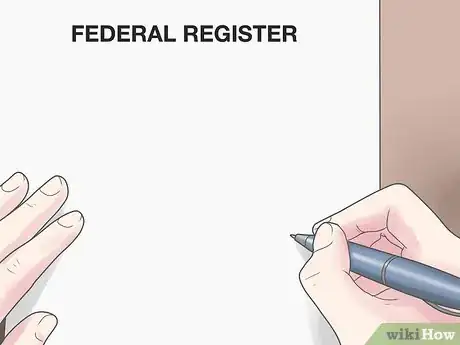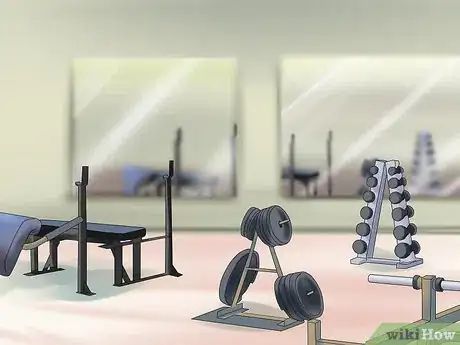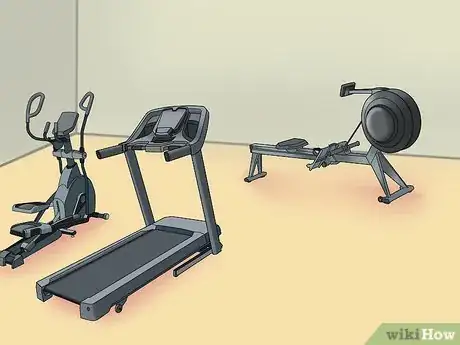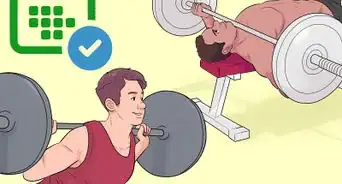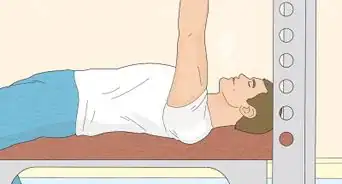wikiHow is a “wiki,” similar to Wikipedia, which means that many of our articles are co-written by multiple authors. To create this article, 29 people, some anonymous, worked to edit and improve it over time.
There are 8 references cited in this article, which can be found at the bottom of the page.
wikiHow marks an article as reader-approved once it receives enough positive feedback. This article received 14 testimonials and 91% of readers who voted found it helpful, earning it our reader-approved status.
This article has been viewed 343,333 times.
Learn more...
Not only are gyms and fitness centers great places for building your muscles — they're also great places for building your personal wealth. Compared to other small-business opportunities, gyms are relatively lucrative. In fact, in 2009, the Small Business Administration pinpointed the fitness industry as having exceptionally high growth potential, even in the face of global recession. However, opening a gym can present unique challenges that aren't part of the equation when it comes to other business opportunities. See Step 1 below to start building your own gym from the ground up.
Steps
Surpassing Legal Hurdles
-
1Apply for an Employer Identification Number (EIN). In the US, most of the legal red tape relating to opening a gym is imposed by state governments, rather than the federal government. However, gyms do have the obligation to pay taxes to the federal government, which means, like many other businesses, that gyms should have an EIN. EINs are only used for tax administration purposes by the IRS[1] and don't qualify the holder to open a gym in and of themselves.
- Applying for an EIN is quite easy. The application can be filled out online, and, upon completion, the applicant will immediately receive his or her EIN.
-
2Apply for a business license. As with most types of businesses, it's necessary to obtain the proper licensing in order to operate your gym legally. However, this process is somewhat complex because different states can have different requirements for which specific licenses are needed to own and operate a gym. Luckily, this information is available online via the Small Business Administration's Licenses and Permits resource.[2]
- As an example of the type of certification you may need to open your gym, in California, a gym can potentially require applying for state and local business licenses.
- One advantage of opening a gym as compared to other forms of business (such as ones that sell alcohol or firearms) is that no federal business licenses are necessary.[3]
Advertisement -
3Register for federal, state, and local taxes. Every business must register to pay taxes. As noted above, every gym can expect to register for federal taxes with an EIN. The tax situation at the state and local level depends upon the location of your gym, however, and can vary based on state and local tax law. Consult your state and local tax agencies for specific tax registration information.
- For example, in California, businesses (including gyms) can be required to register for one or more state-level tax identification numbers, unemployment insurance tax (if the business has employees), state income tax withholding, and more.
-
4Register your business name. Like most other businesses, gyms are required to register the name of their business in order to operate legally. As with tax registration, the precise process here can vary from locality to locality. In situations where the gym is a sole proprietorship, registering a name may not be necessary if the official name of the business can be the same as the gym's owner.
- For example, in California, small businesses are required to register their official "Doing Business As" (DBA) name with the county clerk's office in the county where the gym will operate.
-
5Get insurance. One thing that gyms have to worry about that certain other businesses do not is the possibility that someone using the gym may be injured or even die on-site. Because high-intensity exercise occurs near-constantly during business hours, injury is always a possibility even if extensive safety precautions are taken. Thus, it is a wise idea for gyms to carry liability insurance (depending on state and local laws, this an even be a requirement to operate the gym.
- Most gyms wisely include a clause in members' contracts preventing them from suing in the event of self-caused injury.
-
6If necessary, apply for a daycare license. Many large gyms offer play areas or daycares where young children can be left while their parents work out. Though this is not necessary to run a successful gym, if you do plan to offer this service, you'll almost certainly need to apply for a special daycare or childcare license in addition to the normal business licenses you'll need to run your business. The process for applying for a daycare license can differ from state to state.
- For example, in California, you need a childcare license if you intend to care for children from more than one family who are not related to you.[4]
Planning to Open Your Gym
-
1Pick an accessible, lucrative location. As with other types of small businesses, a significant portion of a gym's success has to do with its location. The location of the gym should be based largely on the population group that it targets. People don't like having to go far out of the way to fulfill their fitness needs. The best gym locations are in areas where there is demand for a gym, where the gym can be easily accessed by its clientele, and in which competition with other gyms, fitness clubs, etc., is minimal or at least manageable. Below are just a few things you may want to consider when choosing a location for your gym:
- Rent. Unless you own your gym's building outright, you'll have to pay rent as one of your gym's operating expenses. Rent can vary from location to location. In wealthy or densely-populated areas, for instance, rent can be very expensive, which can require you to raise membership prices to pay for it.
- Proximity to population centers. If your gym is too far away from your clientele, they won't go to it. Good gym locations should be in or near populated areas or at the very least be easily-accessible via car, bus, train, and so on.
- Local market conditions. Finally, the best gym locations are where there is a demand for a gym that isn't being filled. Opening a gym across the street from an established gym can be a risky move - why deal with the intense competition when you can open a gym in a part of town that is sorely lacking one?
-
2Determine who your gym will target. Make phone calls or conduct door-to-door surveys to determine not only the age and sex of individuals in the area you wish to target, but also the physical activity level of these residents.
-
3Raise capital or get a loan. Like any business, opening a gym costs some money. Obtaining the space for your gym, buying equipment, modifying your building to accommodate the needs of your gym, hiring personnel, and registration/licensing fees can all be substantial cost barriers to open your gym. Most small business owners don't have the money up-front to pay for everything they need to open their business. In these cases, it's necessary to raise the money somehow — this is usually done by persuading wealthy investors to provide capital or simply by getting a loan.
- By some estimates, it can cost anywhere from $200,000 to $500,000, at bare minimum, to open a gym in a place like New York City.[5] For a state of the art gym that features amenities and experienced personnel, the estimates can easily exceed $1 million.
- See: How to Find Investors for a Small Business and How to Get a Loan.
- Note that in both of these situations you will almost always be expected to provide a detailed business plan for the benefit of the people or entities providing you with the money to open your business. This business plan must offer a convincing explanation for how the business can quickly become profitable, or the investors/lenders are unlikely to provide money for your venture.
-
4Consider the option of opening a franchise location. One potentially lucrative option prospective gym owners have is to open a franchise gym, rather than their own independently-operated gym. In this situation, the owner runs the gym for a large chain with many other locations. The parent company usually covers the initial cost of opening the gym and either provides its own equipment or pays for equipment. However, in a franchise situation, most of the profits from the gym go to the parent company. The franchise location may also be subject to sales quotas.[6]
- The parent company also offers its extensive resources to the gym owner, which can include a recognizable, established brand, training opportunities, connections, and financial support during "rough times".
- As with traditional forms of small business financing, franchise opportunities usually require you to submit a detailed business plan to the parent company.
- Be sure to carefully research the pros and cons of a franchise agreement before committing to it. Owning a franchise may sound appealing, but it's usually not a golden ticket when it's all said and done.
Stocking Your Gym
-
1Provide areas and equipment for playing sports. The best gyms offer a wide variety of exercise opportunities to their clientele. These exercise opportunities should cater to the naturally varying interests of the people who use the gym. One fun, relatively easy-to-provide type of exercise is sports. Many popular types of sports can be relatively cheap to offer and maintain. For instance, all that's needed for basketball is several regulation-size hoops, which can be placed indoors, outdoors, or both. Below are several types of sports you may want to offer at your gym (and the space and equipment required for each). Note that many gyms offer only a few of these sports, or none at all:
- Basketball: Regulation-sized hoops and court (can be indoor or outdoor; usually includes regulation floor markings)
- Soccer: Goals, regulation-sized field with regulation markings.
- Running: Track; usually includes starting marks and/or distance markers
- Baseball: Diamond/field or batting cages.
- Boxing/sparring: Indoor ring or gym, punching bags, gloves, and masks.
- Swimming: Indoor or outdoor pool. Olympic-sized is ideal but other sizes common.
-
2Buy free weights. Members of your gym with serious fitness goals will often want to develop muscles, strength, and flexibility. This almost always refers to performing strength building exercises with "free weights" — dumbbells, barbells, kettlebells, and other resistance training tools. Nearly every serious gym will have at least one area of the gym dedicated to housing a wide array of free weights to members. Below are just a few of the types of free weights most serious gyms will offer:
- Bench presses
- Squat racks
- Deadlift mats
- Bicep curl racks
- Pullup/dip racks
- Racks of dumbbells with benches for upper body exercises
-
3Buy isolation machines. Most modern gyms offer isolation machines (sometimes called "Nautilus" machines after the brand name of a popular supplier) in addition to free weights. These machines allow members to exercise one muscle or group of muscles at a time by using the machine to lift adjustable amounts of weights. Though isolation machines can vary in their usefulness in terms of actual strength-building potential, casual gym members generally enjoy these machines because they make it easy to safely perform weight-lifting exercises. Some types of isolation machines found in most gyms are:
- Leg press machines
- Lat pulldown machines
- Tricep extension machines
- Leg extension machines
- Chest fly machines
- Shoulder press machines
-
4Buy cardio machines. Today, most gyms are expected to offer multiple options when it comes to cardio. A wide variety of stationary machines allow members to perform cardio exercise without actually moving around the gym. It's not uncommon for large gyms to have "cardio rooms" packed with dozens of machines. Often, these cardio rooms contain electric fans and television sets to keep members comfortable and entertained while they exercise. Just a few of the types of cardio machines that many gyms offer are:
- Stationary bikes
- Elliptical trainers
- Treadmills
- Stair machines
- Rowing machines
-
5Offer exercise classes. For some gym members, part of the benefit of going to a gym (as opposed to exercising at home) is the social aspect. For these people, exercising in the company of others can be more satisfying and rewarding than exercising alone. To cater to this type of clientele, you may want to offer group exercise classes or programs at your gym. These classes can require you to set aside some of the space in your gym and to hire qualified teachers, but you can offset these costs by charging fees for enrolling in these classes. Below are just a few types of fitness classes you may want to offer at your gym:
- Swimming lessons
- Martial arts classes
- Cycling groups
- Sports camps
- Yoga
- Pilates
- Zumba (or other rhythmic, dance-based exercise opportunities)
Hiring Qualified Personnel
-
1Hire front-of-house staff. The first employees a member usually comes across when walking into a gym are the greeters or front desk staff. These employees are the "face" of your gym, offering a clean, professional "front" and a friendly, welcoming initial interaction to your members. However, these employees are also responsible for loss prevention, ensuring that only registered, paying members enter the gym. In modern gyms, this is usually accomplished by scanning ID cards that are issued to each member upon registration.
- Since greeters and front-desk staff are relatively low-skill positions, they make perfect jobs for low-wage workers, like young students, part-time workers, community volunteers, and so on.
-
2Hire qualified trainers. Some gym members are willing to pay for the services of a qualified, experienced trainer to help them reach their fitness goals. These trainers are usually expected to guide their clients in dedicated one-on-one exercise sessions or small group activities. Trainers are also generally expected to provide clients with detailed plans for achieving their goals outside of the gym in the form of diets, activity schedules, and more.
- The qualifications that gyms look for in a physical trainer vary. Nearly all physical trainers are expected to be athletic and fit themselves and to possess a good knowledge of anatomy and healthy exercise practices. An academic background in health or biology may be required. Good physical trainers are also friendly, open, and personable with a wide variety of clients.
- Personal trainers can obtain certification from a variety of private agencies. However, the standards used by these agencies can vary greatly in terms of strictness. Some major fitness chains don't require their trainers to be certified by one of these private agencies.[7]
-
3Hire exercise class leaders. If your gym offers exercise classes (like yoga, Zumba, swimming lessons, etc.), you will need qualified people to teach these classes. These people can be members of your training staff or outside employees. Regardless of whether you hire from inside or outside your existing staff, you'll want to ensure you choose well-qualified individuals who have both the experience necessary to teach their class well and the ability to effectively manage large groups of people.
- Zumba and other brand-name exercise classes can require their teachers to receive certification from the company that produces and markets the exercise materials.[8] Usually, the certification process is relatively simple and requires brief coursework, a simple test, and a certification fee.
-
4Hire maintenance and janitorial staff. Like any brick and mortar business, gyms require cleaning and maintenance to ensure that the location remains functional, presentable, and safe. However, due to the nature of the activities that take place at a gym, the maintenance requirement may be higher than those of another business of a similar size.
- To ensure your gym runs smoothly, you'll need to hire janitors, groundskeepers, and other low-level maintenance staff. You may also want to subcontract your janitorial work to a janitorial company to eliminate the hassle of hiring dedicated staff.
List of Equipment to Purchase and Promotion Techniques
Community Q&A
-
QuestionWhat should I write on my flyers?
 Community AnswerStart with the basics: the gym's address, open hours, what ages it's suitable for, and the equipment and classes you offer. Include a picture or two, and make your flyers colorful and bold to attract attention. To really attract business you could offer a free session and make sure your prices are competitive for the area. It might be slow at the start but soon enough you'll have a busy gym!
Community AnswerStart with the basics: the gym's address, open hours, what ages it's suitable for, and the equipment and classes you offer. Include a picture or two, and make your flyers colorful and bold to attract attention. To really attract business you could offer a free session and make sure your prices are competitive for the area. It might be slow at the start but soon enough you'll have a busy gym! -
QuestionIs there any downside to opening a gym?
 Community AnswerYes. There is risk involved with any venture.
Community AnswerYes. There is risk involved with any venture. -
QuestionWhat is the minimum amount of money needed to start a gym?
 Community AnswerYou'll need tens of thousands of dollars at a minimum for equipment, rental space and staff.
Community AnswerYou'll need tens of thousands of dollars at a minimum for equipment, rental space and staff.
Warnings
- Have plenty of injury waivers on hand. Keep your equipment in top shape and cover yourself from lawsuits from novice customers trying to do too much with too little.⧼thumbs_response⧽
References
- ↑ http://www.irs.gov/Businesses/Small-Businesses-&-Self-Employed/Apply-for-an-Employer-Identification-Number-(EIN)-Online
- ↑ http://www.sba.gov/licenses-and-permits
- ↑ http://www.sba.gov/content/what-federal-licenses-and-permits-does-your-business-need
- ↑ http://ccld.ca.gov/PG487.htm
- ↑ http://forum.bodybuilding.com/showthread.php?t=2452621
- ↑ http://www.sba.gov/content/franchise-businesses
- ↑ https://www.lafitness.com/Pages/employment.aspx
- ↑ http://www.zumba.com/en-US/trainings
About This Article
To open a gym, start by deciding what type of people you want to come to your gym, such as stay-at-home parents. Then, figure out a location based on the people you’re targeting, like a building that’s close to a daycare or preschool facility. After that, decide whether you want to open a franchise location, where the company will cover the initial cost of opening the gym. Alternatively, open your own gym if you want more independence, and are confident you can raise the necessary capital or secure a loan for your business. For more information, like how to take the appropriate legal steps to open your gym, scroll down!


